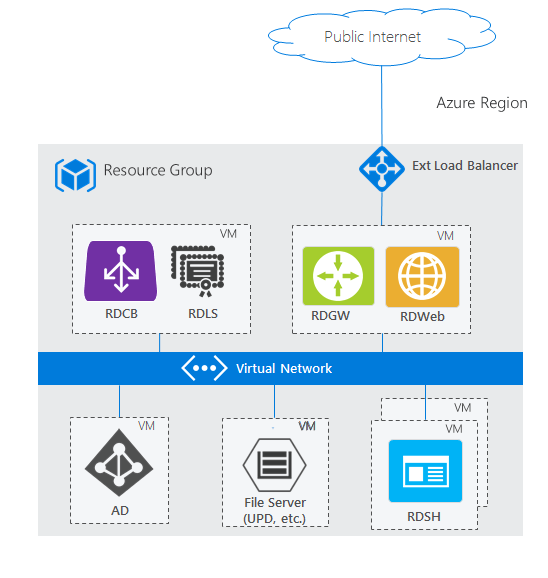Microsoft Azure portal Build, manage, and monitor all Azure products in a single, unified console Azure Purview Maximize business value with unified data governance Azure mobile app Stay connected to your Azure resources—anytime, anywhere. Nov 10, 2020 RDS offers several deployment options, including Windows Server 2016 for on-premises deployment, Microsoft Azure for cloud deployment, and other partner solutions. Depending on your environment and configuration, you can configure an RDS solution with one or both of the following.

Though the standard RDS deployment architectures fit most scenarios, Azure continues to invest in first-party PaaS solutions that drive customer value. Below are some architectures showing how they incorporate with RDS. RDS deployment with Azure AD Domain Services. The two standard architecture diagrams above are based on a traditional Active Directory (AD) deployed on a Windows Server VM. The perfect solution to setup a basic RDS IaaS farm in Azure as a Windows virtual desktop infrastructure service solution (VDI,VDS). Great for testing or a production environment. Scale from 1 RDS Host to 50 RDS Hosts. Perfect solution for virtual desktops in the cloud.
-->Applies to: Windows Server (Semi-Annual Channel), Windows Server 2019, Windows Server 2016
Below are various configurations for deploying Remote Desktop Services to host Windows apps and desktops for end-users.
Note
The architecture diagrams below show using RDS in Azure. However, you can deploy Remote Desktop Services on-premises and on other clouds. These diagrams are primarily intended to illustrate how the RDS roles are colocated and use other services.
Standard RDS deployment architectures
Remote Desktop Services has two standard architectures:
- Basic deployment – This contains the minimum number of servers to create a fully effective RDS environment
- Highly available deployment – This contains all necessary components to have the highest guaranteed uptime for your RDS environment
Basic deployment
Microsoft Azure Rds Software
Highly available deployment
RDS architectures with unique Azure PaaS roles
Though the standard RDS deployment architectures fit most scenarios, Azure continues to invest in first-party PaaS solutions that drive customer value. Below are some architectures showing how they incorporate with RDS.

Though the standard RDS deployment architectures fit most scenarios, Azure continues to invest in first-party PaaS solutions that drive customer value. Below are some architectures showing how they incorporate with RDS. RDS deployment with Azure AD Domain Services. The two standard architecture diagrams above are based on a traditional Active Directory (AD) deployed on a Windows Server VM. The perfect solution to setup a basic RDS IaaS farm in Azure as a Windows virtual desktop infrastructure service solution (VDI,VDS). Great for testing or a production environment. Scale from 1 RDS Host to 50 RDS Hosts. Perfect solution for virtual desktops in the cloud.
-->Applies to: Windows Server (Semi-Annual Channel), Windows Server 2019, Windows Server 2016
Below are various configurations for deploying Remote Desktop Services to host Windows apps and desktops for end-users.
Note
The architecture diagrams below show using RDS in Azure. However, you can deploy Remote Desktop Services on-premises and on other clouds. These diagrams are primarily intended to illustrate how the RDS roles are colocated and use other services.
Standard RDS deployment architectures
Remote Desktop Services has two standard architectures:
- Basic deployment – This contains the minimum number of servers to create a fully effective RDS environment
- Highly available deployment – This contains all necessary components to have the highest guaranteed uptime for your RDS environment
Basic deployment
Microsoft Azure Rds Software
Highly available deployment
RDS architectures with unique Azure PaaS roles
Though the standard RDS deployment architectures fit most scenarios, Azure continues to invest in first-party PaaS solutions that drive customer value. Below are some architectures showing how they incorporate with RDS.
Microsoft Azure Rds Software
RDS deployment with Azure AD Domain Services
The two standard architecture diagrams above are based on a traditional Active Directory (AD) deployed on a Windows Server VM. However, if you don't have a traditional AD and only have an Azure AD tenant—through services like Office365—but still want to leverage RDS, you can use Azure AD Domain Services to create a fully managed domain in your Azure IaaS environment that uses the same users that exist in your Azure AD tenant. This removes the complexity of manually syncing users and managing more virtual machines. Azure AD Domain Services can work in either deployment: basic or highly available.
RDS deployment with Azure AD Application Proxy
The two standard architecture diagrams above use the RD Web/Gateway servers as the Internet-facing entry point into the RDS system. For some environments, administrators would prefer to remove their own servers from the perimeter and instead use technologies that also provide additional security through reverse proxy technologies. The Azure AD Application Proxy PaaS role fits nicely with this scenario.
Microsoft Azure Rds Training
For supported configurations and how to create this setup, see how to publish Remote Desktop with Azure AD Application Proxy.

